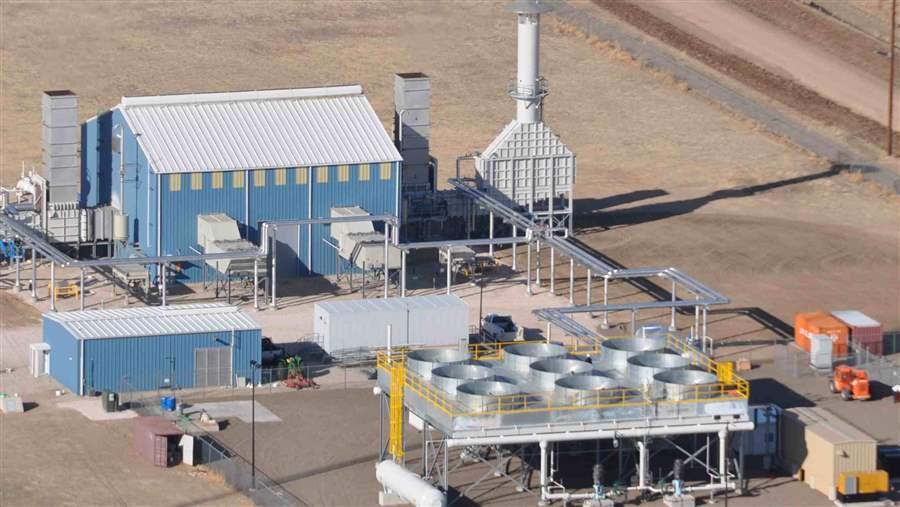Efficiency Technologies in Oil and Gas Industry Reduce Energy Use
 © Ormat
© OrmatThe trailblazer pipeline.
Overview
Two energy-efficient technologies, combined heat and power (CHP) and waste heat to power (WHP), are reducing energy costs, increasing efficiency, and improving reliability while delivering other environmental benefits. But there is potential for their expanded use. Changes to federal tax financing policies can help support greater adoption of these proven technologies across the oil and gas sector.
By producing both heat and power from a single fuel source, combined heat and power has double the efficiency of central station power generation. Waste heat to power captures waste heat that would typically be vented from an industrial facility and uses it to make electricity with no additional combustion and no incremental emissions. Both CHP and WHP dramatically lower energy use, emissions, and costs.
Increased efficiency reduces energy costs
CHP and WHP can be used in a variety of industrial applications that have significant and coincident power and thermal loads. Combined heat and power has a long history in the industrial sector. Facilities in the chemicals, metal, oil refining, pulp and paper, and food processing sectors represent more than 80 percent of total global capacity for electric CHP.1 In the United States, CHP provides 18 percent of power and steam to oil and gas industries.2
Basic processes such as oil recovery, petroleum refining, natural gas distillation, and pipeline compressor stations use large amounts of energy, but many facilities that conduct these operations still release wasted heat into the atmosphere rather than harnessing it for power production. CHP and WHP can also be practical solutions at sites with hot water, steam, or other thermal loads.3 These highly efficient power-generating systems deliver more energy from a given amount of initial fuel, dramatically reducing costs.
Success stories
Combined heat and power and wasted heat to power installations are delivering efficiency and cost savings to the oil and gas industry in states across the country.
For example:
Targa Resources, which operates a natural gas distillation facility in Mont Belvieu, Texas, examined the possibility of on-site power generation using CHP in an effort to improve the efficiency and reliability of its heating plant as well as the potential to expand its facilities.4 In 2009, the company installed a 15-megawatt (MW) CHP project, which today provides as much as 90 percent of the facility’s electricity.
The Trailblazer Pipeline runs 436 miles across Wyoming, Colorado, and Nebraska and is outfitted with compressor stations along its route. Heat is produced as a byproduct of the pressurized systems which push the fuel from station to station. The heat from all of the stations along the way is collected and delivered to the compressor station in northeastern Colorado, which recycles the wasted heat through a 3.5-MW WHP system that provides power to the electric grid. Over the course of the 20-year agreement, system operators expect to save more than $10 million.
Eliminating financial barriers to CHP and WHP
CHP and WHP systems offer the oil and gas industry proven methods to improve efficiency, power quality, energy reliability, and security while lowering energy costs. Despite these benefits, technical and financial hurdles continue to limit more widespread adoption of efficiency technologies. These obstacles include narrow recognition of WHP as a renewable energy source, limited incentive programs, and a lack of access to financing. Government policies are needed to create equity and parity in energy policy to further reduce the capital cost of CHP and WHP and increase its deployment.
Endnotes
- Center for Climate and Energy Solutions, “Cogeneration/Combined Heat and Power (CHP),” http://www.c2es.org/technology/factsheet/CogenerationCHP.
- U.S. Department of Energy and U.S. Environmental Protection Agency, “Combined Heat and Power: A Clean Energy Solution” (August 2012), https://www1.eere.energy.gov/manufactering/distributedenergy/pdfs/ chp_clean_energy_solution.pdf, 11.
- U.S. Department of Energy, CHP Technical Assistance Partnerships: Southwest, “Natural Gas Pipeline Compressor Stations,” http://www. southwestchptap.org/industrial-naturalgas.
- U.S. Department of Energy, Gulf Coast Clean Energy Application Center, “Targa Resources Project Profile,” http://files.harc.edu/sites/gulfcoastchp/projectprofiles/targa.pdf.






